Nitrogen management improves lodging resistance and production in maize (Zea mays L.) at a high plant density
lrshad AHMAD ,Maksat BATYRBEK ,Khushnuma lKRAM ,Shakeel AHMAD ,Muhammad KAMRAN ,Misbah,Raham Sher KHAN,HOU Fu-jiang,HAN Qing-fang
1 Key Laboratory of Crop Physio-Ecology and Tillage Science in North-Western Loess Plateau,Ministry of Agriculture/College of Agronomy,Northwest A&F University,Yangling 712100,P.R.China
2 State Key Laboratory of Herbage Improvement and Grassland Agro-Ecosystems/Key Laboratory of Grassland Livestock Industry Innovation,Ministry of Agriculture and Rural Affairs/Engineering Research Center of Grassland Industry,Ministry of Education/College of Pastoral Agriculture Science and Technology,Lanzhou University,Lanzhou 730020,P.R.China
3 Department of Biotechnology,Abdul Wali Khan University Mardan,Mardan 23200,Pakistan
Abstract Lodging in maize leads to yield losses worldwide.In this study,we determined the effects of traditional and optimized nitrogen management strategies on culm morphological characteristics,culm mechanical strength,lignin content,root growth,lodging percentage and production in maize at a high plant density.We compared a traditional nitrogen(N) application rate of 300 kg ha-1 (R) and an optimized N application rate of 225 kg ha-1 (O) under four N application modes: 50% of N applied at sowing and 50% at the 10th-leaf stage (N1);100% of N applied at sowing (N2);40% of N applied at sowing,40% at the 10th-leaf stage and 20% at tasseling stage (N3);and 30% of N applied at sowing,30% at the 10th-leaf stage,20% at the tasseling stage,and 20% at the silking stage (N4).The optimized N rate(225 kg ha-1) significantly reduced internode lengths,plant height,ear height,center of gravity height and lodging percentage.The optimized N rate significantly increased internode diameters,filling degrees,culm mechanical strength,root growth and lignin content.The application of N in four split doses (N4) significantly improved culm morphological characteristics,culm mechanical strength,lignin content,and root growth,while it reduced internode lengths,plant height,ear height,center of gravity height and lodging percentage.Internode diameters,filling degrees,culm mechanical strength,lignin content,number and diameter of brace roots,root volume,root dry weight,bleeding safe and grain yield were significantly negatively correlated with plant height,ear height,center of gravity height,internode lengths and lodging percentage.In conclusion,treatment ON4 significantly reduced the lodging percentage by improving the culm morphological characteristics,culm mechanical strength,lignin content,and root growth,so it improved the production of the maize crop at a high plant density.
Keywords: high plant density,lodging resistance,maize,nitrogen rates,nitrogen application modes
1.lntroduction
Maize (Zea maysL.) is an important cereal crop,which provides many products for human consumption,feed for livestock and biofuels (Liet al.2016).In China,the plant densities of maize (2014-2016) were 67 700 plants ha-1in the northwest maize planting region,61 900 plants ha-1in the Huang-Huai-Hai plain summer maize planting region,59 100 plants ha-1in the northern spring maize planting region,51 300 plants ha-1in the southern sweetwaxy maize planting region,and 48 000 plants ha-1in the southwestern maize planting region (Minget al.2017).In recent years,the plant density of maize in China has increased from 97 500 to 105 000 plants ha-1(Kamranet al.2018;Liuet al.2021;Zhanget al.2022).Using a high plant density is an important strategy for improving the production of the maize crop (Xueet al.2016;Zhanget al.2022).However,a high plant density leads to lodging stress in plants (Novaceket al.2013),because with a high plant density the light penetration in the canopy is lower which leads to a greater plant height with thinner stems,and thus results in lodging (Tianet al.2016).Lodging stress weakens water,nutrient and photosynthate transport and results in grain yield reduction (Liet al.2015).Lodging stress also has a negative effect on the number of kernels per square meter,kernel weight and dry matter assimilation,as well as reducing the crop quality (Carter and Hudelson 1988;Berryet al.2004).In lodged crops,mechanical harvesting also leads to yield losses (Kamaraet al.2003;Shiet al.2019).Lodging stress results in 5 to 25 or 100% yield losses in maize in some years (Sekhonet al.2020;Xueet al.2020;Manga-Robleset al.2021).Stalk lodging in densely populated maize constitutes more than 60% of lodging,and leads to 1 Mt of annual loss in Chinese maize production (Fenget al.2008;Gouet al.2010).Due to climatic change,the frequency of extreme weather conditions could increase lodging in maize (Guoet al.2021).Due to the 2020 storm in Northeast China,large areas of maize were lodged.Various biotic (corn borers,insects,fungal pathogens and diseases,etc.) and abiotic factors (high plant density,heavy rains,storm,hail,excessive and imbalanced nitrogen (N) fertilization)can lead to lodging stress (López-Malvaret al.2017;Xuet al.2017;Kamranet al.2018).Lodging in maize mostly occurs at the third basal internode (3rd BI) at the grainfilling stage due to the transport of stalk carbohydrates to the ear,which thus decreases basal internode quality (Gouet al.2007;Ahmadet al.2018).The 3rd BI is an important internode that acts as a lever and holds the maize plants erect (Yuanet al.2002).In addition to the 3rd BI,the ear internode (EI) is another important internode,and improving EI strength is also crucial for lodging resistance in maize (Ahmadet al.2021b).Therefore,improving the strength of the 3rd BI and EI as well as root strength are important for enhancing lodging resistance in maize at a high plant density.
N is an essential macro-nutrient that is crucial for crop growth and development (Wuet al.2019;Suet al.2020;Ahmadet al.2021a,b).However,the overestimation of the advantages of N in crop production and misunderstandings of their relationships have led farmers to overuse N fertilizers (Maet al.2017;Suet al.2020).Applying the full dose of N fertilizer at sowing is a common practice of farmers in most parts of the world(Subediet al.2007).Excessive application of N can lead to a decrease in N use efficiency and the degradation of environmental quality (Wu and Ma 2015;Menget al.2021).Furthermore,excessive N fertilization can also lead to higher internode lengths and plant height,lower cellulose accumulation in the stalk and enhanced lodging percentage (Wu and Ma 2018;Liet al.2010).Therefore,efficient N management is important for improving crop production (Cuiet al.2006;Ahmadet al.2021a,b).The timing and suitable N application rates are the important strategies in N management (Wuet al.2019;Suet al.2020).Previous research has suggested that the optimum application of N in two split doses (half at sowing and half at the jointing stage) reduces the lodging percentage and increases the grain protein content in winter wheat (Wuet al.2019).Chenet al.(2018) also found that optimized N application in split doses reduced the lodging percentage and increased the grain yield in winter wheat.Thus,applying the optimum N in split doses could reduce the lodging percentage and improve the grain yield in maize at a high plant density.
Our previous experiments suggested that the application of a plant growth retardant improved lodging resistance in maize and winter wheat (Ahmadet al.2018,2020).Our previous experiments also suggested that uniconazole and N application under low and high plant densities reduced the lodging percentage in maize(Ahmadet al.2021b).In the current study,we determined the effects on culm morphological characteristics,culm mechanical strength,lignin content,root growth,yield and yield attributes of maize at a high plant density of two N rates,i.e.,300 kg N ha-1(traditional N rate) and 225 kg N ha-1(optimized N rate),under four N application modes:50% of N applied at sowing and 50% at the 10th-leaf stage(N1);100% of N applied at sowing (N2);40% of N applied at sowing,40% at the 10th-leaf stage and 20% at the tasseling stage (N3);and 30% of N applied at sowing,30%at the 10th-leaf stage,20% at the tasseling stage,and 20% at the silking stage (N4).We selected a high plant density (126 583 plants ha-1) because the maize hybrid used was adapted to a high plant density.Furthermore,this research will be useful for fodder maize production in order to reduce the lodging rate,because fodder maize is normally grown at a high plant density.Moreover,the excessive and imbalanced usage of N fertilizers is also the main cause of lodging stress in maize,especially at a high plant density.Therefore,we carried out this experiment to determine the best N rate and N application mode in order to reduce the lodging percentage and improve the production of maize crops at a high plant density.The results of the present study provide important insights regarding reducing the lodging percentage and improving the maize grain yield at a high plant density.
2.Materials and methods
2.1.Experimental location
A two year-field experiment was conducted at the research station of Northwest A&F University,China,(34°21′N,108°04′E,466.7 m a.s.l.).The study site is located in the Guanzhong plain,China with annual precipitation of 550-600 mm and an average temperature of 12.9°C (Xuet al.2020).The frost-free period of the experimental site was 210 d with annual sunshine hours of 2 463.8 (Wuet al.2021).The precipitation and temperature during the 2018 and 2019 growth seasons were measured with an automatic weather station and are shown in Fig.1.The 0-20 cm soil depth of the experimental site contained 10.56 g kg-1organic matter,45.37 g kg-1alkaline-hydrolyzed N,13.29 g kg-1available phosphorus and 109.62 g kg-1available potassium.
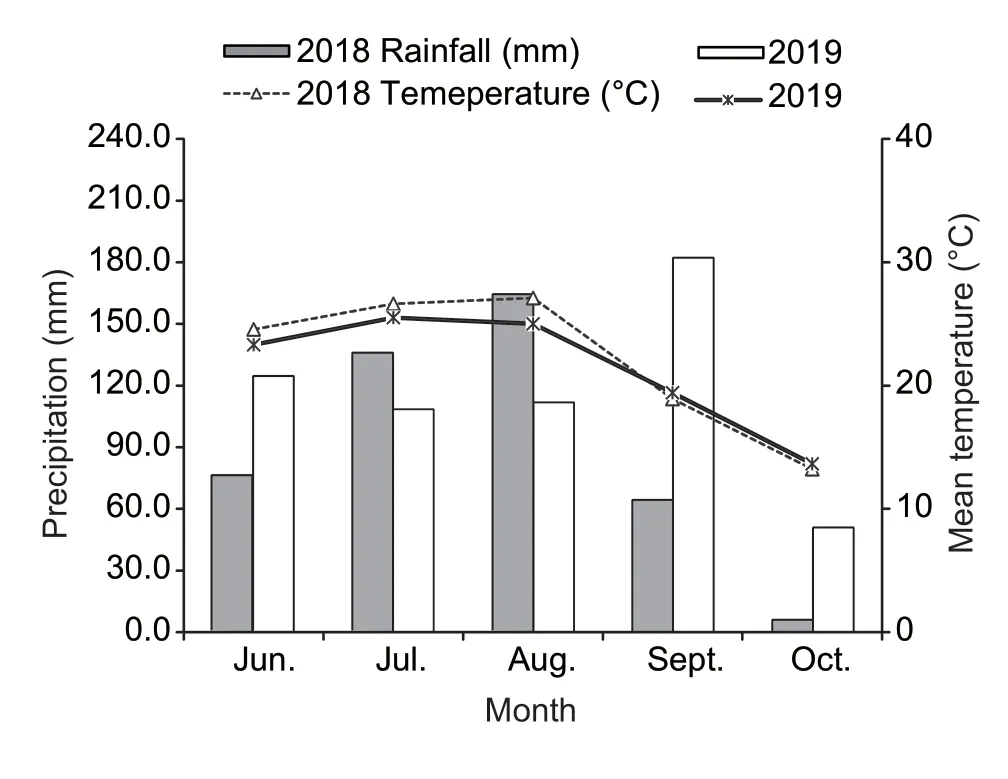
Fig.1 Monthly precipitation (mm) and mean temperature (°C)during 2018 and 2019 growth seasons at the Institute of Water Saving Agriculture in Arid Areas of China.
2.2.Experimental design,treatments and field management
The experimental design used was factorial design with three replications.There were two factors in the experiment.Factor A was N rate,i.e.,300 kg ha-1(traditional N rate,R) and 225 kg ha-1(optimized N rate,O),and factor B was N application mode: N1,N2,N3,and N4.The treatment combinations comprised RN1,RN2,RN3,RN4,ON1,ON2,ON3 and ON4.The N doses at pre-planting were uniformly broadcasted in each treatment,whereas the remaining N doses were uniformly side dressed.Maize variety Zhengdan 958 (ZD958) was sown in the experiment.Each plot was 35 m2(7 m×5 m).The row-to-row spacing was maintained at 50 cm and the intra-plant spacing at 15.8 cm.The recommended doses of phosphorus and potassium (150 kg ha-1) were applied at pre-planting.Sowing was conducted on 15 and 17 June and harvesting on 9 and 10 October in 2018 and 2019,respectively.Thinning was carried out at the 4-leaf stage to maintain a uniform plant density of 126 583 plants ha-1.All other agronomic practices were carried out uniformly for all the treatments.The maize crop during both growth seasons was dependent on natural precipitation.
2.3.Measurements and sampling
Length (cm),diameter (mm),and filling degree (g cm-1)of the 3rd Bl and ElThe lengths,diameters and filling degrees of the 3rd BI and EI were measured at the milk stage (R3) during both growth seasons on five randomly selected plants per replication in the middle rows.Internode lengths were measured with a measuring tape.Internode diameters were measured with a digital vernier caliper (0.001 mm).The internodes were dried in an oven at 80°C until constant weight in order to measure the filling degree.The filling degree was calculated according to our previous experiment by dividing internode dry weight by internode length (Ahmadet al.2020).
lnternode puncture strength (lPS) and internode bending strength (lBS) of the 3rd Bl and ElThe IPS and IBS of the 3rd BI and EI were measured at the silking stage (R1),milk stage (R3) and physiological maturity stage (R6) on five randomly sampled plants in each replication in the middle rows while avoiding the two side rows.The IPS and IBS of the 3rd BI and EI were measured with a stalk strength tester (YYD-1;Hangzhou TOP Inst.,China).
Lignin contents in the 3rd Bl and ElThe lignin contents in the 3rd BI and EI were determined at the R1,R3 and R6 stages using five randomly sampled plants per replication in central rows while avoiding the side rows.Lignin content was analyzed as reported by Wanget al.(2015).
Plant height,ear height and center of gravity heightThe plant height,ear height and center of gravity height(fulcrum of the balance location) were measured at the R3 stage on five randomly selected plants in each replication.
Number and diameter of brace roots,root volume,root dry weight and bleeding safe from the 3rd BlThe number and diameter of brace roots,root volume and root dry weight were measured at the R3 stage on five randomly selected plants in each replication in the middle rows while avoiding the side rows.The root system of the 0-30 cm soil depth was dug from the center of the plant,between two plants in the same row and in between two rows.The roots were immediately rinsed with water.The numbers of brace roots were counted on the above-soil internodes.The roots were then scanned with an EPSON V800 high resolution scanner (Epson India Pvt Ltd.),and WinRHIZO Root Analysis Software was used to determine the root diameter and root volume.The roots were then dried in an oven at 80°C until constant weight and the dry weight of the root were measured.
The bleeding safe from the 3rd BI was determined at the R1,R3 and R6 stages for five plants in central rows while avoiding the side rows.At 6:00 p.m.,the plants were cut at the 3rd BI.The remaining internodes were enclosed with rubber bags containing cotton.The rubber bags were collected the next morning at 6:00 a.m.Bleeding safe from the 3rd BI was calculated as the overnight weight increase of the bag.
Lodging percentage (%)The lodging percentage was measured at harvest maturity in the six middle rows during both growth seasons as described by Xuet al.(2017).The lodging percentage (%) was calculated by dividing the total number of lodged plants by the total number of plants in the six central rows.
Ear diameter (mm),rows per ear,kernels per row,kernels per ear and grain yield (t ha-1)The six central rows previously used for determining the lodging percentage were hand harvested.The cobs were removed from the husks and air-dried,and the grain yield was determined after threshing.Ten ears per replication were randomly selected from those harvested rows for the determination of the ear diameter,rows per ear,kernels per row and kernels per ear.Ear diameter was measured with a digital vernier caliper.
2.4.Statistical analysis
Analysis of variance was determined with Statistix 8.1 Software.The least significance difference test atP≤0.05 was used for means comparisons.Pearson’s correlation analysis was conducted to find the relationships between number of brace roots,IBS,center of gravity height,diameter of brace root,ear height,filling degrees,grain yield,internode diameters,internode lengths,lodging percentage,lignin content,plant height,root bleeding safe,IPS,root volume and root dry weight.
3.Results
3.1.lnternode lengths,internode diameters and filling degrees
The N rates and N application modes affected internode lengths,internode diameters and filling degrees during both growth seasons (Table 1).The effects of N rates and N application modes on the lengths,diameters,and filling degrees of the 3rd BI and EI were significant,whereas the interactions between N rates and N application modes on these parameters were non-significant during both growth seasons.Internode lengths were higher and internode diameters and filling degrees were lower during the 2018 growth season compared with the 2019 growth season.The 3rd BI has greater length,diameter and filling degree values compared with the EI.The application of 300 kg N ha-1led to higher internode lengths and lower internode diameters and filling degrees compared with the 225 kg N ha-1treatment.The application of N in four split doses(N4) led to lower internode lengths and higher internode diameters and filling degrees compared with the other N application modes.The means of data for the two years showed that treatments ON1,ON2,ON3,and ON4 reduced the lengths of the 3rd BI (by 4.5,3.8,6.7 and 9.7%,respectively) and EI (by 4.8,4.9,9.9 and 9.5%,respectively),while they increased the diameters of the 3rd BI (by 3.7,4.7,3.8 and 5.3%,respectively) and EI (by 3.8,7.9,6.7 and 9.0%,respectively),and the filling degrees of the 3rd BI (by 7.9,12.7,5.9 and 16.0%,respectively),and EI (by 11.8,15.4,9.8 and 34.7%,respectively)compared with the RN1,RN2,RN3 and RN4 treatments.The minimum internode lengths and maximum internode diameters and filling degrees were recorded in ON4.
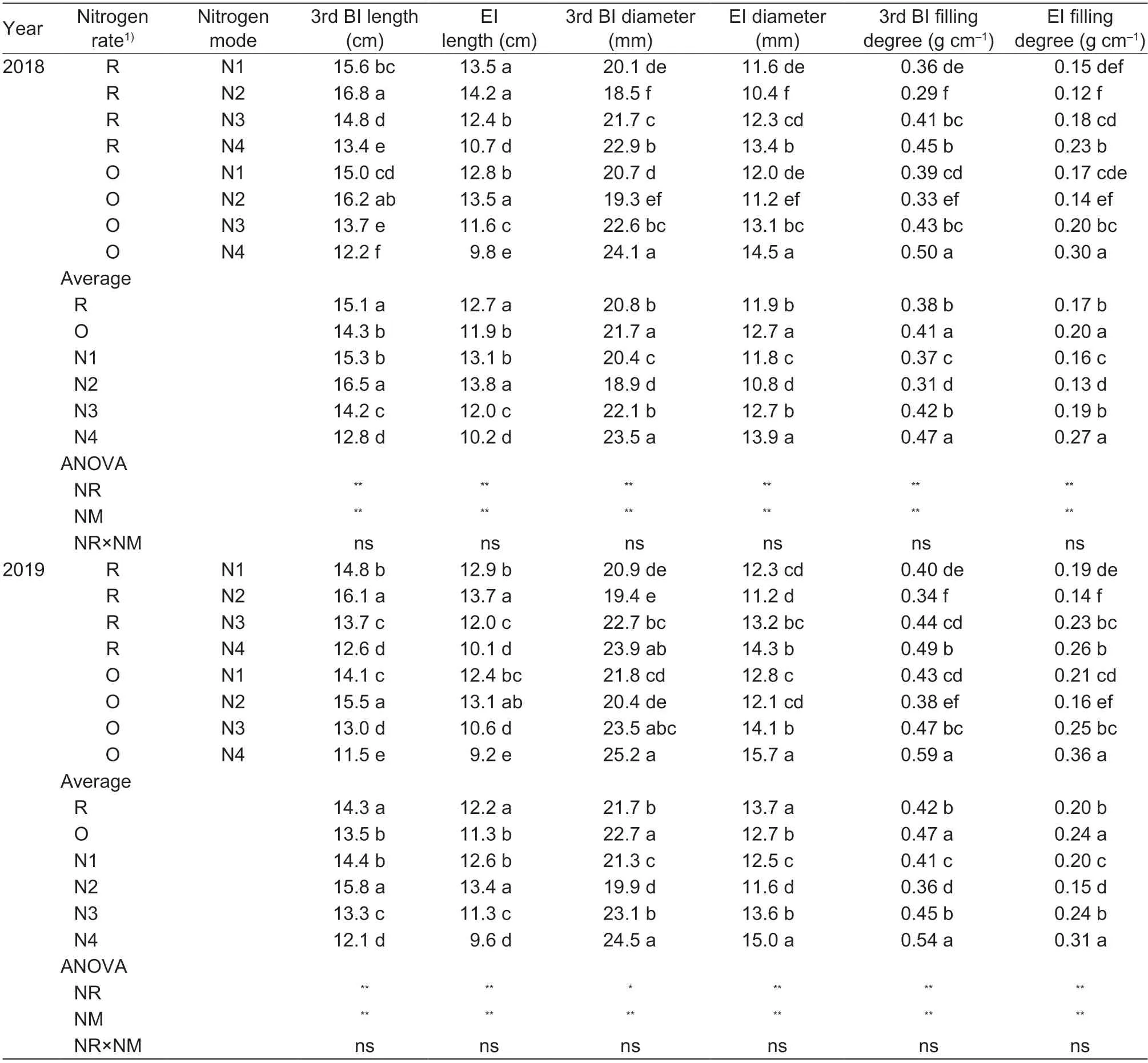
Table 1 Effects of nitrogen rates and nitrogen application modes on the third basal internode (3rd BI) and ear internode (EI) lengths,diameters and filling degrees at the milk stage (R3) of maize in 2018 and 2019
3.2.Culm mechanical strength
The N rates and N application modes significantly affected IPS and IBS of the 3rd BI and EI during both growth seasons (Tables 2 and 3).The interactions between N rates and N application modes on IPS of EI at the R3 and R6 stages during 2018 and on the 3rd BI at the R1 and R3 stages and EI at the R1,R3 and R6 stages during the 2019 growth season were significant.The interactions between N rates and N application modes on the IBS of the 3rd BI at the R1,R3 and R6 stages and EI at the R1 and R6 stagesduring the 2019 growth season were also significant.The IPS and IBS of the 3rd BI and EI were higher in 2019 compared with 2018.The 3rd BI has higher IPS and IBS values compared with the EI.The IPS of the 3rd BI and EI were lower at the R1 stage,reached the maximum at the R3 stage and decrease again at the R6 stage.The IBS values of the 3rd BI and EI were higher at the R1 stage and then decreased until the R6 stage.The application of 300 kg N ha-1led to lower culm mechanical strength compared with 225 kg N ha-1,and the application of N in four split doses (N4) led to higher culm mechanical strength compared with the other N application modes.The meansof data for the two years and three growth stages showed that treatments ON1,ON2,ON3,and ON4 increased IPS of the 3rd BI (by 3.5,7.8,3.6 and 7.2%,respectively) and EI (by 8.0,10.6,7.9 and 20.9%,respectively),as well as IBS of the 3rd BI (by 3.9,4.6,3.4 and 7.6%,respectively)and EI (by 5.5,11.3,7.9 and 11.9%,respectively)compared with the RN1,RN2,RN3 and RN4 treatments.The maximum culm mechanical strength during both growth seasons was recorded in the ON4 treatment and the minimum was in the RN2 treatment.
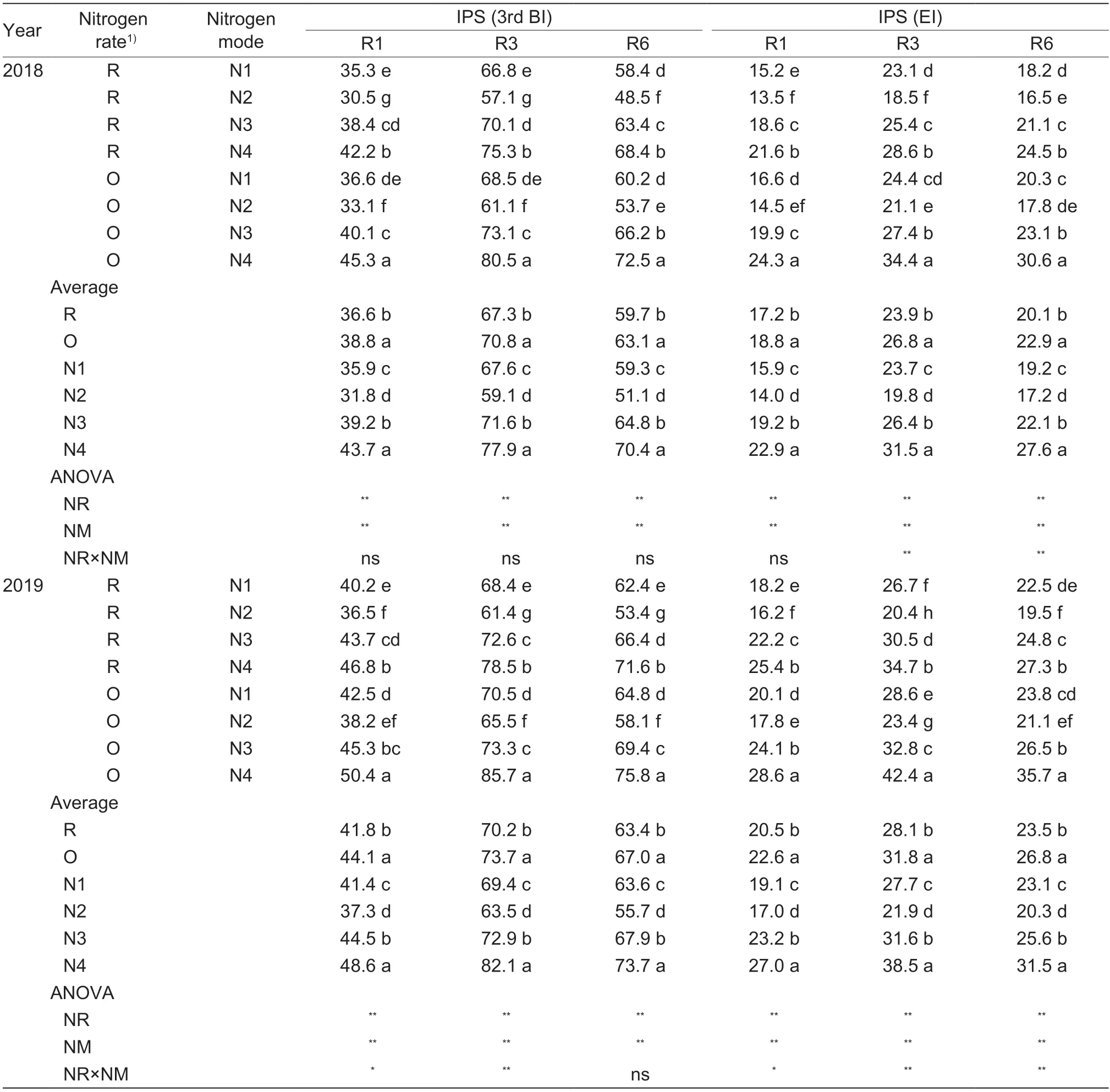
Table 2 Effects of nitrogen rates and nitrogen application modes on the internode puncture strength (IPS,N (newton)) of the third basal internode (3rd BI) and ear internode (EI) at the silking stage (R1),milk stage (R3) and physiological maturity stage (R6) of maize in 2018 and 2019
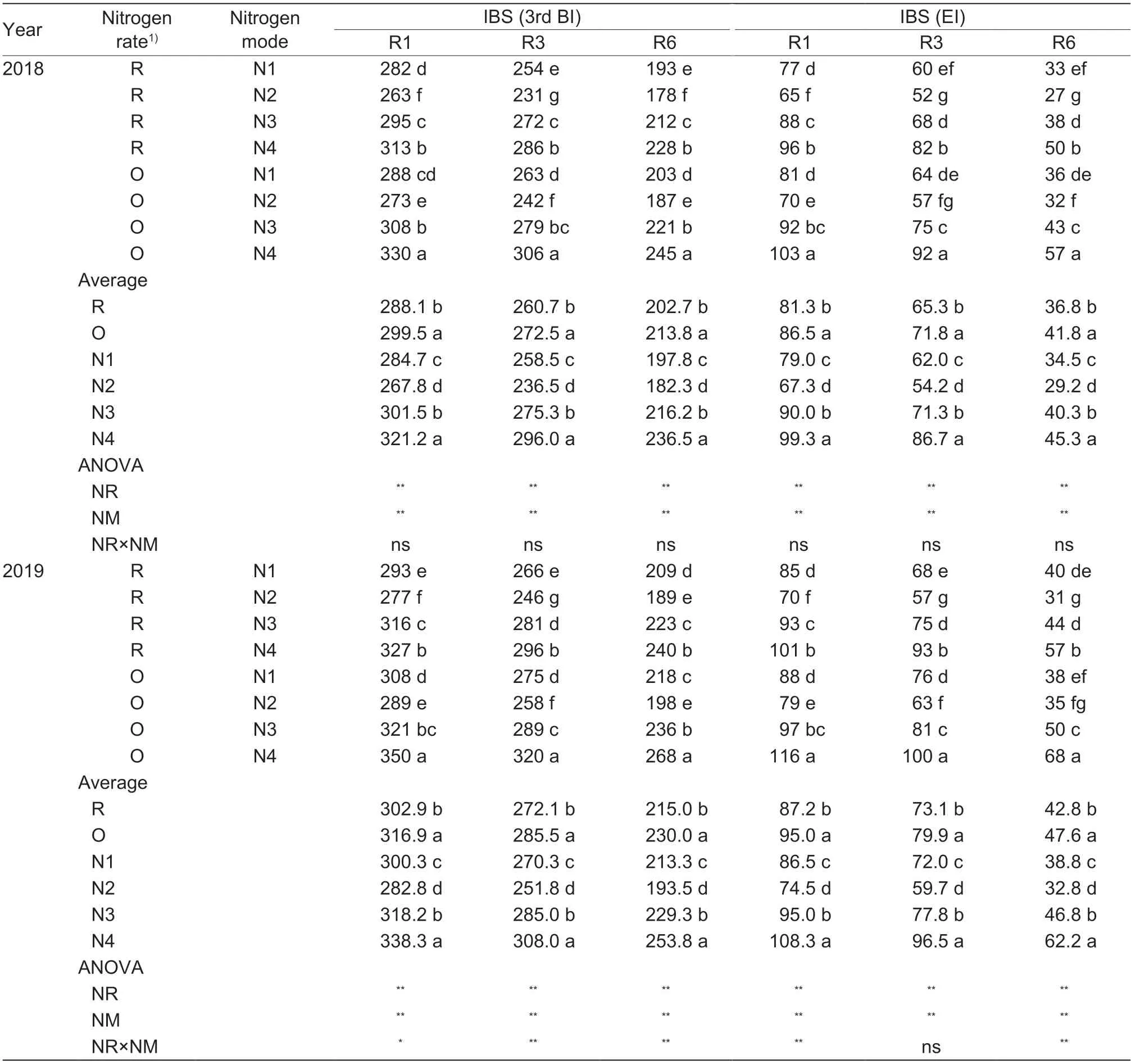
Table 3 Effects of nitrogen rates and nitrogen application modes on the internode bending strength (IBS,N (newton)) of the third basal internode (3rd BI) and ear internode (EI) at the silking stage (R1),milk stage (R3) and physiological maturity stage (R6) of maize in 2018 and 2019
3.3.Lignin content
The lignin content in the internodes was significantly affected by N rates and N application modes during both growth seasons (Table 4).The interactions between Nrates and N application modes on lignin contents in the 3rd BI at the R1,R3 and R6 stages and in EI at the R3 and R6 stages during 2018,and in the 3rd BI and EI at the R1,R3 and R6 stages during 2019 were all significant.The lignin contents in the internodes were lower in 2018 and higher in 2019,and the lignin contents in the 3rd BI were higher compared with the EI.The lignin contents in the 3rd BI and EI increased from the R1 stage and reached their maxima at the R3 stage and then decreased at the R6 stage.The optimized N rate (225 kg ha-1)significantly improved the lignin contents in the 3rd BI and EI compared with the traditional N rate (300 kg ha-1).The application of N in four split doses (N4) led to high lignin contents in the 3rd BI and EI compared with the other N application modes.The maximum lignin contents in the 3rd BI and EI were recorded in ON4,and the minimum lignin content was in RN2.The means of data for the two years and three growth stages showed that treatments ON1,ON2,ON3 and ON4 increased the lignin contents in the 3rd BI (by 5.4,6.5,5.6 and 13.5%,respectively) and EI (by 7.2,7.1,8.2 and 17.2%,respectively) compared with the RN1,RN2,RN3 and RN4 treatments.
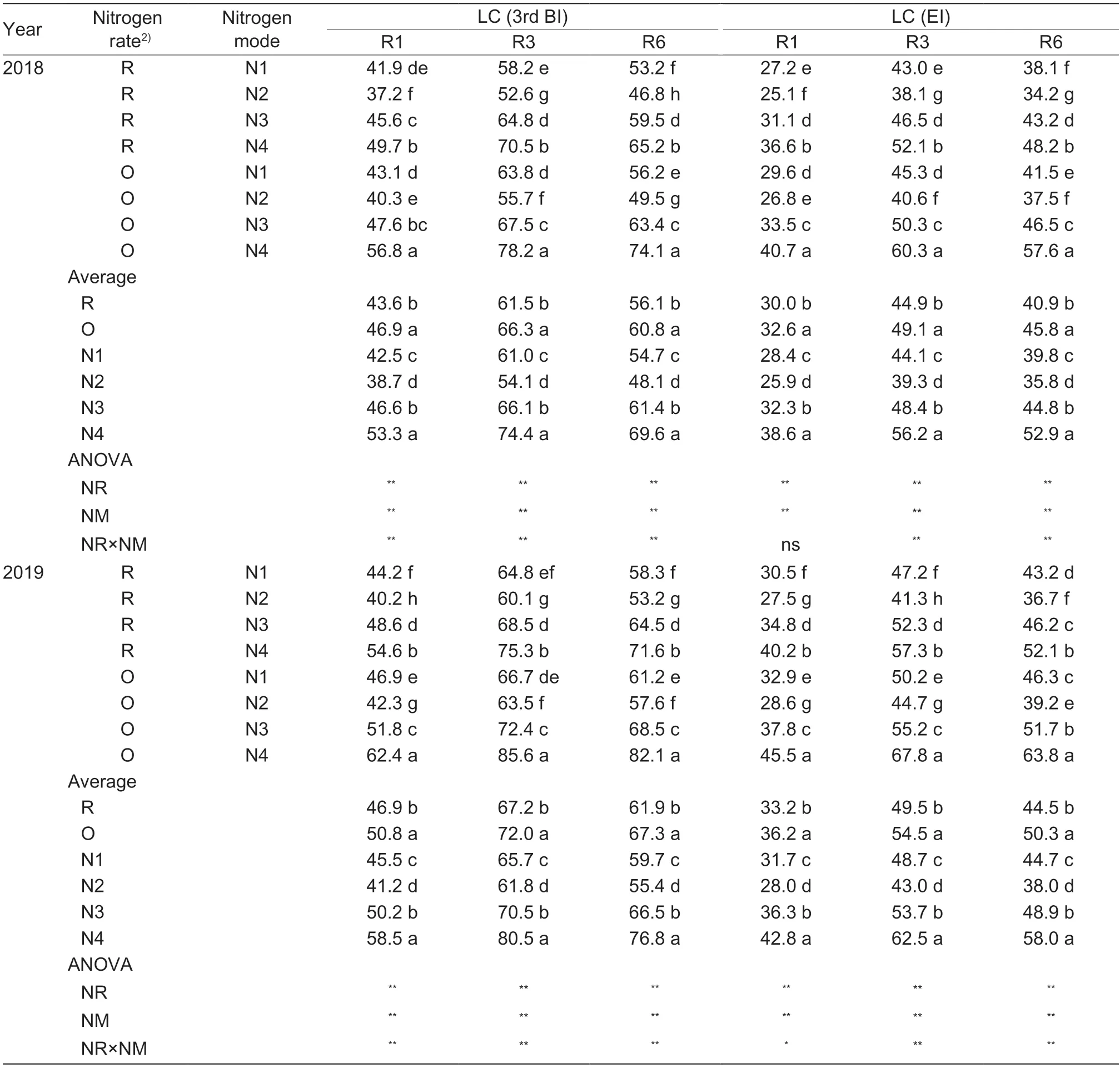
Table 4 Effects of nitrogen rates and nitrogen application modes on the lignin content (LC,mg g-1 FM) of the third basal internode(3rd BI) and ear internode (EI) at the silking stage (R1),milk stage (R3) and physiological maturity stage (R6) of maize in 2018 and 2019
3.4.Plant height,ear height and center of gravity height
The N rates and N application modes significantly affected plant height,ear height and center of gravity height during both growth seasons (Table 5).The interaction between N rates and N application modes on ear height during 2018 was significant.Plant height,ear height and center of gravity height were higher in the 2018 growth season compared with the 2019 growth season.The traditional N rate led to the maximum plant height,ear height and center of gravity height compared with the optimized N rate.Mode N2 led to higher plant height,ear height and center of gravity height compared with the other N application modes.The maximum plant height,ear height and center of gravity height values were recorded in RN2 and the minimum values were in ON4.The mean data for the two years indicated that treatments ON1,ON2,ON3 and ON4 reduced plant height (by 1.9,1.7,2.1 and 3.0%,respectively),ear height (by 2.7,5.5,4.1 and 7.3%,respectively),and center of gravity height (by 2.5,4.0,4.3 and 5.1%,respectively)compared with the RN1,RN2,RN3 and RN4 treatments.
3.5.Root growth and bleeding safe from the 3rd Bl
The number of brace roots,diameter of brace root,root volume and root dry weight were significantly affected by N rates and N application modes during both growth seasons (Table 6).Bleeding safe values from the 3rd BI at the R1,R3 and R6 stages were also affected significantly by N rates and N application modes during both growth seasons (Fig.2).The interactions between N rates and N application modes on the number of brace roots,diameter of brace root,root volume,root dry weight and bleeding safe from the 3rd BI were non-significant.The number and diameter of brace roots,root volume,root dry weight and bleeding safe from the 3rd BI were higher in the 2019 growth season compared with the 2018 growth season.Bleeding safe from the 3rd BI was higher at the R1 stage and gradually decreased until the R6 stage.The optimized N rate (225 kg ha-1) led to higher number of brace roots,diameter of brace root,root volume,root dry weight and bleeding safe from the3rd BI compared with the traditional N rate (300 kg ha-1).Applying the N in four split doses (N4) produced the maximum number of brace roots,diameter of brace root,root volume,root dry weight and bleeding safe from the 3rd BI compared with the other N application modes.The maximum number of brace roots,diameter of brace root,root volume,root dry weight and bleeding safe values from the 3rd BI were recorded in ON4,while the minimum values were in RN2.The means based on two years of data showed that treatments ON1,ON2,ON3 and ON4 improved the number of brace roots (by 3.3,9.4,4.1 and 6.8%,respectively),diameter of brace root (by 2.3,7.1,2.8 and 4.0%,respectively),root volume (by 5.7,6.4,4.5 and 5.5%,respectively) and root dry weight (by 7.5,7.5,6.7 and 11.3%,respectively) compared with the RN1,RN2,RN3 and RN4 treatments.The mean data for the two years and three growth stages showed that treatments ON1,ON2,ON3 and ON4 improved bleeding safe from the 3rd BI by 4.3,8.7,4.9 and 7.3%,respectively,compared with the RN1,RN2,RN3 and RN4 treatments.
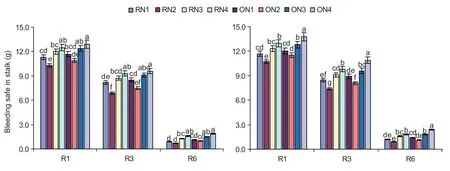
Fig.2 Effects of nitrogen rates and nitrogen application modes on bleeding safe from the third basal internode at the silking stage(R1),milk stage (R3),and physiological maturity stage (R6) of maize in 2018 and 2019.RN1,300 kg N ha-1 and 50% N applied at sowing and 50% at the 10th-leaf stage;RN2,300 kg N ha-1 and 100% N applied at sowing;RN3,300 kg N ha-1 and 40% N applied at sowing,40% at the 10th-leaf stage,and 20% at the tasseling stage;RN4,300 kg N ha-1 and 30% N applied at sowing,30% at the 10th-leaf stage,20% at the tasseling stage,and 20% at the silking stage;ON1,225 kg N ha-1 and 50% N applied at sowing and 50% at the 10th-leaf stage;ON2,225 kg N ha-1 and 100% N applied at sowing;ON3,225 kg N ha-1 and 40% N applied at sowing,40% at the 10th-leaf stage,and 20% at the tasseling stage;ON4,225 kg N ha-1 and 30% N applied at sowing,30% at the 10th-leaf stage,20% at the tasseling stage,and 20% at the silking stage.Vertical bars represent the standard error of the mean(n=3).Lowercase letters indicate significant differences at P≤0.05 (LSD test).
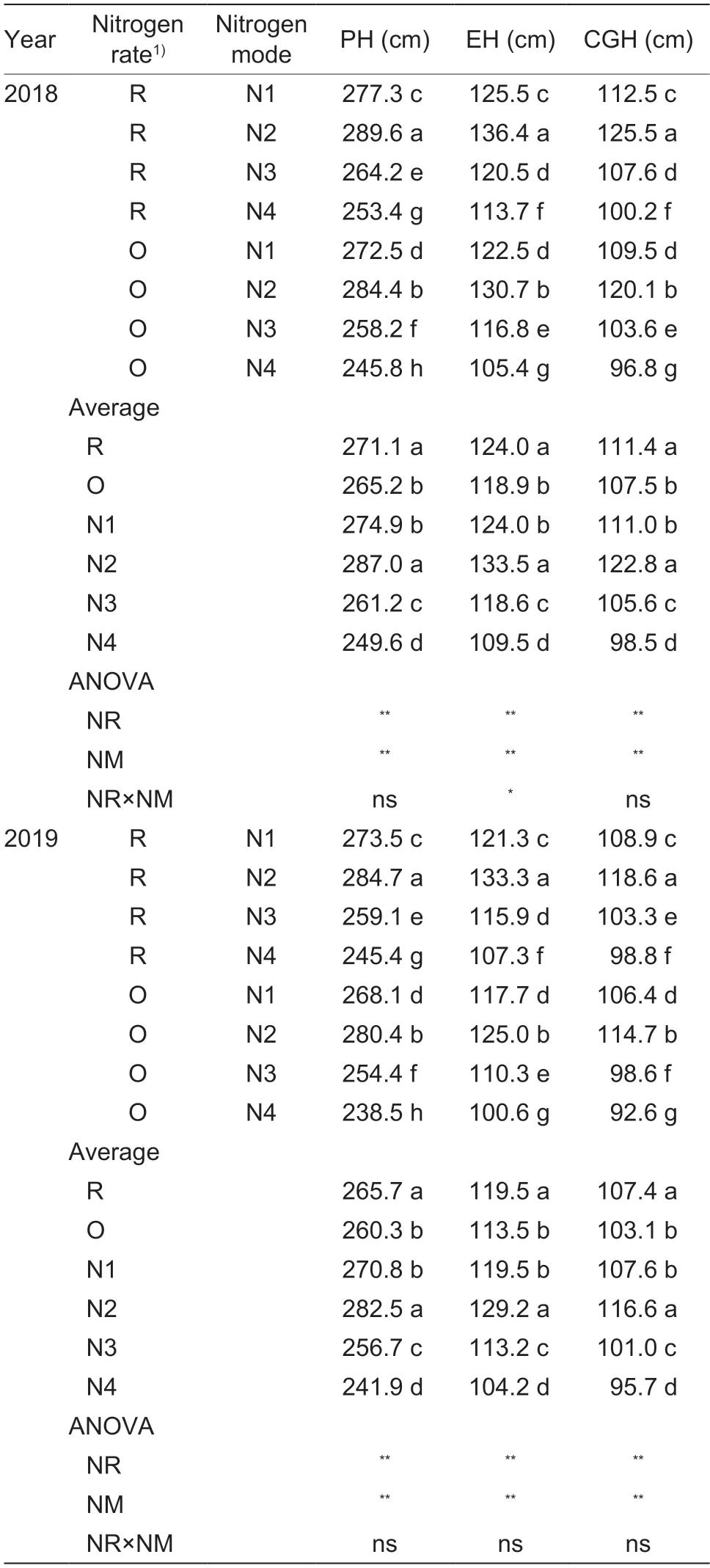
Table 5 Effects of nitrogen rates and nitrogen application modes on plant height (PH,cm),ear height (EH,cm) and center of gravity height (CGH,cm) at the milk stage (R3) of maize in 2018 and 2019
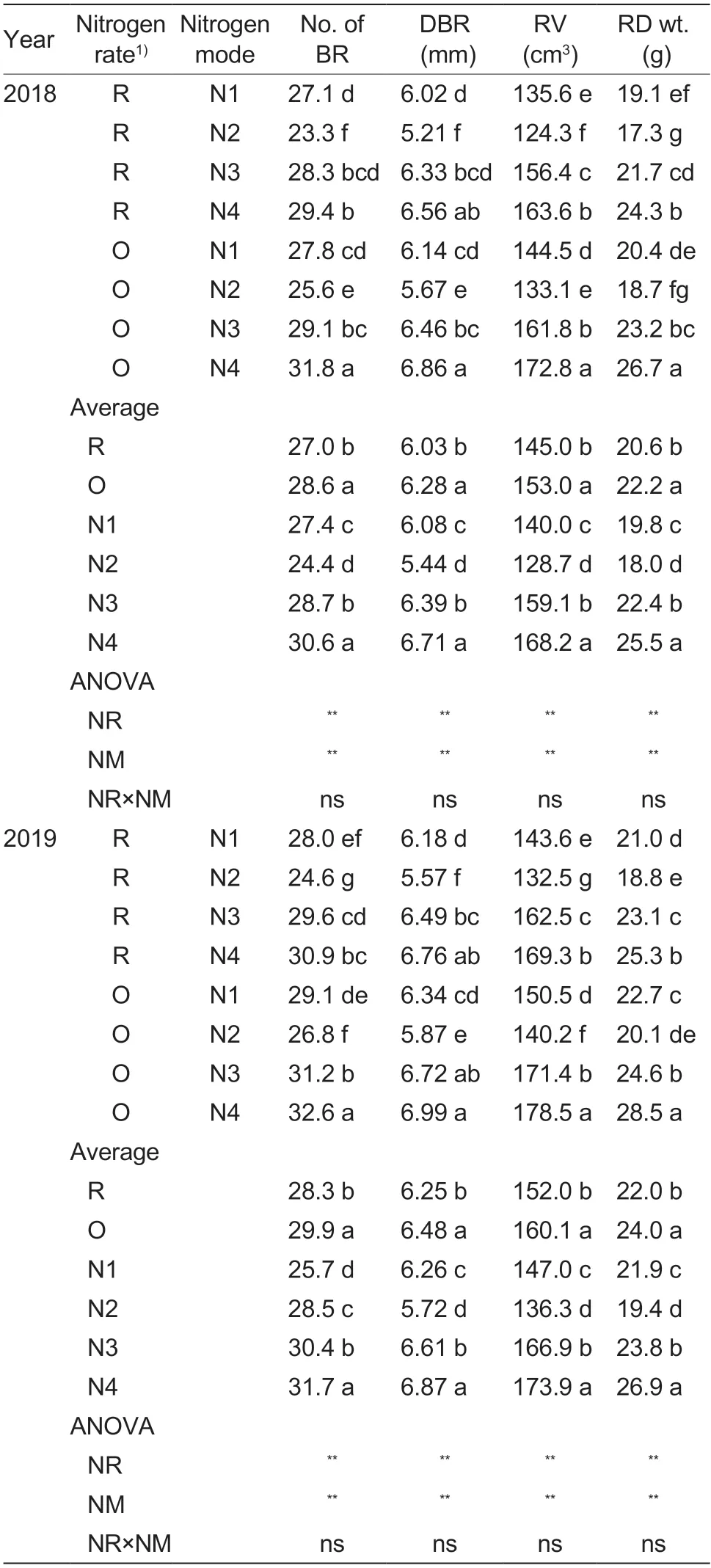
Table 6 Effects of nitrogen rates and nitrogen application modes on number of brace roots (no.of BR),diameter of brace root (DBR,mm),root volume (RV,cm3),and root dry weight(RD wt.,g) at the milk stage (R3) of maize in 2018 and 2019
3.6.Lodging percentage (%)
Lodging percentage was significantly affected by the N rates and N application modes during the 2018 and 2019 growth seasons (Fig.3).The lodging percentages were higher in 2018 compared with 2019.The application of 225 kg N ha-1significantly reduced the lodging percentage compared with the 300 kg N ha-1rate.Mode N4 gave the minimum lodging percentages,whereas N2 gave the highest lodging percentages during both growth seasons.The mean data for the two years showed that treatments ON1,ON2,ON3 and ON4 reduced the lodging percentages by 19.2,51.5,76.3 and 123.7%,respectively,compared with the RN1,RN2,RN3 and RN4 treatments.
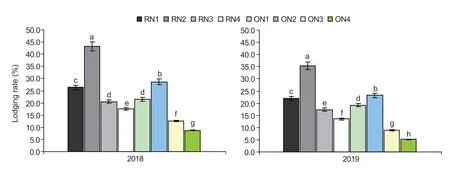
Fig.3 Effects of nitrogen rates and nitrogen application modes on the lodging percentage (%) of maize at harvest maturity in 2018 and 2019.RN1,300 kg N ha-1 and 50% N applied at sowing and 50% at the 10th-leaf stage;RN2,300 kg N ha-1 and 100% N applied at sowing;RN3,300 kg N ha-1 and 40% N applied at sowing,40% at the 10th-leaf stage,and 20% at the tasseling stage;RN4,300 kg N ha-1 and 30% N applied at sowing,30% at the 10th-leaf stage,20% at the tasseling stage,and 20% at the silking stage;ON1,225 kg N ha-1 and 50% N applied at sowing and 50% at the 10th-leaf stage;ON2,225 kg N ha-1 and 100% N applied at sowing;ON3,225 kg N ha-1 and 40% N applied at sowing,40% at the 10th-leaf stage,and 20% at the tasseling stage;ON4,225 kg N ha-1 and 30% N applied at sowing,30% at the 10th-leaf stage,20% at the tasseling stage,and 20% at the silking stage.Vertical bars represent the standard error of the mean (n=3).Lowercase letters indicate significant differences at P≤0.05 (LSD test).
3.7.Grain yield and yield attributes
The N rates and N application modes significantly affected ear diameter,rows per ear,kernels per rows,kernels per ear and grain yield during 2018 and 2019 (Table 7).The interactions between N rates and N application modes on grain yield in 2018 and on kernels per ear and grain yield during 2019 were significant.The ear diameter,rows per ear,kernels per rows,kernels per ear,and grain yield values were higher in 2019 and lower in 2018.The optimized N rate (225 kg ha-1) significantly improved ear diameter,rows per ear,kernels per rows,kernels per ear,and grain yield compared with the traditional N rate (300 kg ha-1).Applying the N rates in four split doses (N4) led to the maximum ear diameter,rows per ear,kernels per rows,kernels per ear,and grain yield,whereas N2 produced the minimum values of these traits compared with the other N application modes.The mean data for the two years showed that treatments ON1,ON2,ON3 and ON4 improved ear diameter (by 3.2,6.4,5.6 and 7.2%,respectively),rows per ear (by 4.1,8.5,8.9 and 6.4%,respectively),kernels per row (by 7.8,14.7,11.9 and 14.0%,respectively),kernels per ear (by 12.2,24.4,21.9 and 21.4%,respectively),and grain yield (by 5.7,42.0,12.0 and 11.1%,respectively) compared with the RN1,RN2,RN3 and RN4 treatments.The maximum ear diameter,rows per ear,kernels per rows,kernels per ear,and grain yield during both growth seasons were recorded in ON4,while the minimum values were in the RN2 treatment.
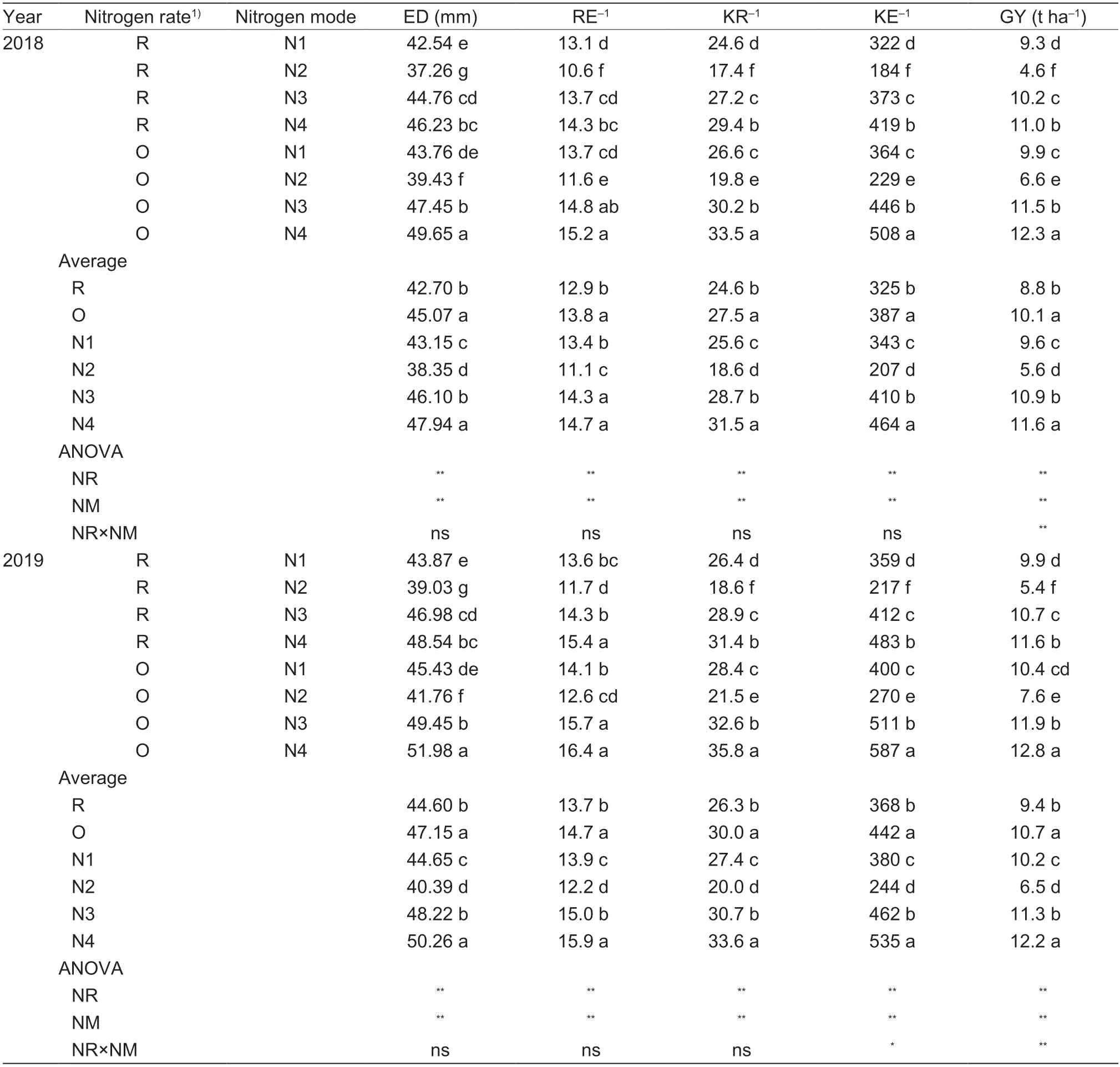
Table 7 Effects of nitrogen rates and nitrogen application modes on ear diameter (ED,mm),rows per ear (RE-1),kernels per row(KR-1),kernels per ear (KE-1),and grain yield (GY) of maize in 2018 and 2019
3.8.Relationships between culm morphological characteristics,culm mechanical strength,root characteristics,grain yield and lodging percentage
The correlation analysis showed that there were significant positive correlations between internode diameters,filling degrees,IPS,IBS,lignin content,number of brace roots,diameter of brace root,root volume,root dry weight,bleeding safe from the third basal internode and grain yield (Table 8).There were significant positive correlations between plant height,ear height,center of gravity height,internode lengths and lodging percentage.Internode diameters,filling degrees,IPS,IBS,lignin content,number of brace roots,diameter of brace root,root volume,root dry weight,bleeding safe and grain yield were all significantly negatively correlated with plant height,ear height,center of gravity height,internode lengths and lodging percentage.

4.Discussion
4.1.Culm morphological characteristics and their relations with lodging resistance in maize
Increasing the plant density and optimum N application are important for improving the grain yield in maize (Xuet al.2017;Kamranet al.2018;Suet al.2020;Ahmadet al.2021a,b).However,a high plant density leads to lodging stress due to the reduction in light intensity within maize canopy(Xueet al.2016).Previous research suggested that lodging could reduce the grain yield by up to 80% (Berry and Spink 2012).Improving the internode diameters and reducing the plant height,ear height and center of gravity could reduce the lodging percentage in maize (Kamranet al.2018).Our results showed that the N rates and N application modes significantly affected the basal internode characteristics,plant height,ear height and center of gravity height.The application of N at a rate of 225 kg ha-1in four split doses (30% of N applied at sowing,30% at the 10th-leaf stage,20% at the tasseling stage and 20% at the silking stage) significantly improved internode diameters and filling degrees while it reduced internode lengths,plant height,ear height and center of gravity height.In maize,lodging resistance can be determined by plant and ear heights,the length and diameter of basal internodes and stem wall thickness (Sposaroet al.2008;Novaceket al.2013;Kamranet al.2018).Our previous study suggested that improving the diameters and dry weights per unit length of the 3rd BI and EI reduced the lodging percentage (Ahmadet al.2021b).Our previous study also suggested that a higher N rate increased the internode lengths,plant height,ear height and height above ear,while it reduced the internode diameters and dry weight per unit length(Ahmadet al.2021b).Chenet al.(2018) also reported that an optimized N application in split doses improved the culm lodging resistance of the winter wheat crop.Thus,our findings showed that treatment ON4 significantly reduced the lodging percentage by enhancing internode diameters and filling degrees and reduced internode lengths,plant height,ear height and center of gravity height.
4.2.Effects of N rates and N application modes on lignin content and culm mechanical strength,and its relation with lodging resistance in maize
Improving lignin metabolism and culm mechanical strength are important for reducing the lodging percentage in buckwheat (Wanget al.2015),maize(Kamranet al.2018),and winter wheat (Zhenget al.2017;Chenet al.2018).Lignin is a complex phenolic hetero-polymer which provides mechanical strength to plants (Wanget al.2015;Ahmadet al.2018;Hussainet al.2020).Previous research suggested that a high plant density could reduce the stalk puncture strength(Guoet al.2016).Liet al.(2021) suggested that high lignin accumulation reduced the lodging percentage in maize,and increasing the plant density reduced lignin metabolism and culm mechanical strength.Our results showed that the lignin content and culm mechanical strength are important for enhancing lodging resistance in maize.The N rates and N application modes significantly affected lignin content and culm mechanical strength,and the N application rate of 225 kg ha-1significantly improved them compared with 300 kg N ha-1.Our results are consistent with Liuet al.(2021) who also suggested that N application at higher rates reduced the lignin content.Our previous research suggested that low and high N rates reduced the lignin content,IPS and IBS(Ahmadet al.2021b).The optimized N rate applied in four split doses (N4) significantly improved the lignin content and culm mechanical strength.Chenet al.(2018)also suggested that an optimized N rate applied in split doses improved the lignin content and reduced lodging percentage in wheat.The higher lignin content and culm mechanical strength in the ON4 treatment reduced the lodging percentage compared with the other treatments.
4.3.Effects of N rates and N application modes on root characteristics and their relations with lodging resistance in maize
The root provides support to plants and poor development of the root system could increase the lodging percentage (Kamaraet al.2003).At a high plant density,shoot growth increases due to competition for light,and root growth decreases especially in the top 0-20 cm layer due to competition for space and nutrients,which thus increases the risk of lodging in plants (Hébertet al.2001;Chenet al.2012).Furthermore,the number of brace roots,node levels and root weight all decrease under a high plant density(Huanget al.2009),as do root diameter and root activity(Liet al.2012;Liuet al.2012).The number of roots,growth direction of roots and root diameter affect root lodging (Stam 1992).Due to these changes in root growth,the lodging percentage increases (Bianet al.2016).The application of N at a rate of 225 kg-1in four split doses (30% of N applied at sowing,30% at the 10th-leaf stage,20% at the tasseling stage,and 20%at the silking stage) significantly improved the number and diameter of brace roots,root volume,root dry weight,and root bleeding safe compared with the other treatments.Liuet al.(2021) showed that N fertilization and plant growth regulator application significantly improved the number of brace roots,diameter of brace roots,root angle,root volume,and root weight,and significantly reduced the lodging percentage in maize.Suet al.(2020) also suggested that N rates improved the root growth and development in maize.Our findings showed that the ON4 treatment significantly improved root growth and bleeding safe from the 3rd BI and also reduced the lodging percentage compared with the other treatments.
4.4.Relationships between lodging resistance traits with lodging percentage and grain yield
A correlation analysis showed that the internode diameters,filling degrees,IPS,IBS,lignin content,number and diameter of brace roots,root volume,root dry weight,root bleeding safe and grain yield were all significantly negatively correlated with the internode lengths,plant height,ear height,center of gravity height and lodging percentage.Previous research indicated that the lodging percentage was significantly negatively correlated with the stem diameter and stem puncture strength (Guoet al.2016;Xueet al.2016;Liet al.2021).Previous research also suggested that lodging resistance has a positive correlation with the dry weight per unit length,culm mechanical strength and grain yield (Gouet al.2007;Kamranet al.2018).With an increase in the lodging rate,the grain yield gradually decreased.N application at a rate of 225 kg ha-1in four split doses (30% of N applied at sowing,30% at the 10th-leaf stage,20% at the tasseling stage,and 20% at the silking stage) significantly improved the culm morphological characteristics,culm mechanical strength,lignin content,root growth and grain yield,and it reduced the lodging percentage in maize at a high plant density.
5.Conclusion
The N rates and N application modes tested in this study significantly affected the culm morphological characteristics,culm mechanical strength,root growth and lodging percentage in maize at a high plant density.The application of N at a rate of 225 kg ha-1significantly reduced the lodging percentage and increased the grain yield of maize by improving the culm morphological characteristics,culm mechanical strength,lignin content and root growth compared with the N application rate of 300 kg ha-1.Compared with other N application modes,N4 significantly improved the culm morphological characteristics,culm mechanical strength,root growth and lignin accumulation,and thus reduced the lodging percentage.Root characteristics,culm mechanical strength,lignin content and grain yield were significantly negatively correlated with lodging percentage.The treatment ON4 led to the maximum grain yield by improving the culm morphological characteristics,culm mechanical strength,lignin content and root growth and reduced lodging percentage.
Acknowledgements
This work was supported by projects funded by China Postdoctoral Science Foundation (2019M663837 and 2021M701521),the National High-Tech Research and Development Programs of China (2013AA102902),and the special fund for Agro-scientific Research in the Public Interest,China (201303104).
Declaration of competing interest
The authors declare that they have no conflict of interest.
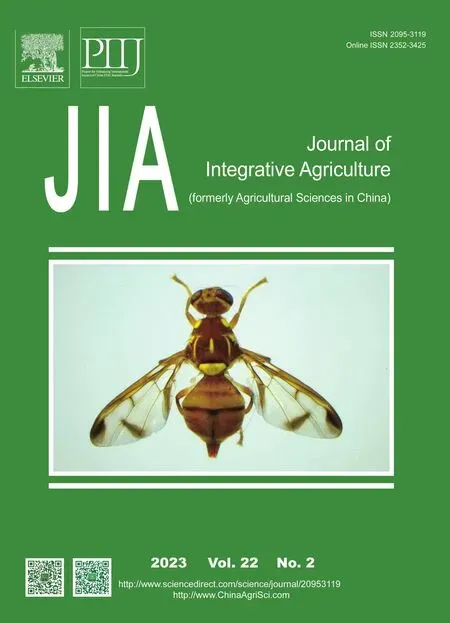 Journal of Integrative Agriculture2023年2期
Journal of Integrative Agriculture2023年2期
- Journal of Integrative Agriculture的其它文章
- A 314-bp SlNE insertion in the ZNF2 promoter region may act as a repressor related to regulation of fat deposition in pigs
- An optimized protocol using Steedman’s wax for high-sensitivity RNA in situ hybridization in shoot apical meristems and flower buds of cucumber
- Characterization of subunits encoded by SnRK1 and dissection of combinations among these subunits in sorghum (Sorghum bicolor L.)
- The role of time preferences in contract breach: Evidence from Chinese poultry farmers participating in contract farming
- Optimal design of culling compensation policy under the African swine fever — Based on simulations of typical pig farms in China
- Drip fertigation and plant hedgerows significantly reduce nitrogen and phosphorus losses and maintain high fruit yields in intensive orchards
